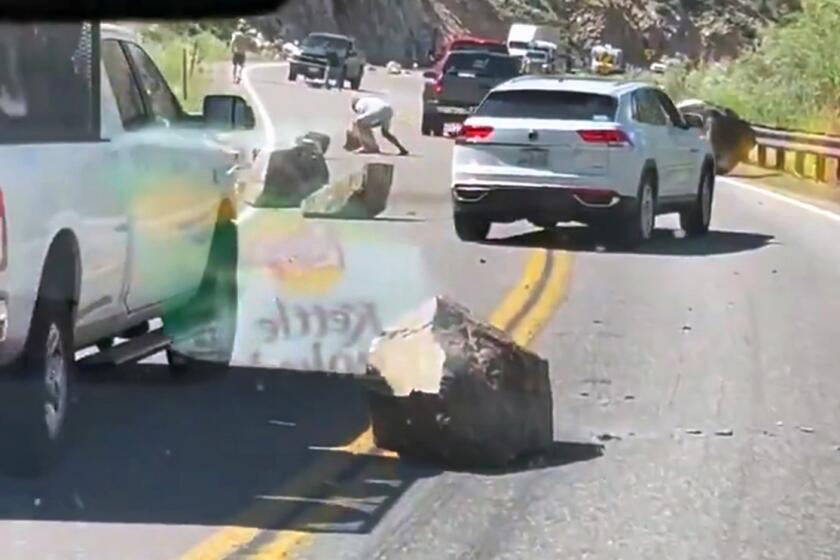After 6.0 quake sends rocks, merchandise falling, scores of aftershocks rattle Sierra Nevada
- Share via
SAN FRANCISCO — The magnitude 6.0 earthquake that shook large parts of Northern California on Thursday caused rockslides around the epicenter near the Nevada border and rattled nerves. But there were no reports of significant damage or injuries.
The quake has produced more than 100 aftershocks, and many more are expected in the coming days.
The earthquake was reported at 3:49 p.m. The preliminary epicenter was just west of the town of Walker, where fewer than 1,000 people live, on the northern edge of Mono County about 70 miles northwest of Mammoth Mountain and 40 miles southeast of South Lake Tahoe.
Lorri Martin, a deli supervisor at Walker Country Store, had been sticking labels on merchandise when she first felt the shaking.
Items in the refrigerator tipped over. Coolers began leaking water. Martin screamed and then stood in the bathroom doorway to try to calm down.
“This thing shook like it was moving onto the highway,” she said. “It rocked and rolled. Everything broke.”
Get earthquake-ready in six weeks
From building a kit to buying insurance, our Unshaken newsletter course will help you prepare.
You may occasionally receive promotional content from the Los Angeles Times.
But customers kept arriving, and over the next few minutes, as staff began to clean up broken glass, the small convenience store continued to feel jolts.
About a mile away at Mountain View Barbeque, pots and pans flew off shelves.
“I’ve been here 27 years and this was the first time — it was a jolt, it was just a bam,” owner Jeff Hinds said.
The guide to earthquake readiness and resilience that you’ll actually use.
Weak to light shaking was felt as far away as Lake Tahoe, Sacramento, San Francisco and San Jose, according to the U.S. Geological Survey. But the shaking reported was not uniform, and some people in the East Bay and San Mateo County felt nothing at all.
“The ground was shaking pretty bad, and then everything started falling,” Carolina Estrada, manager at the Walker Coffee Co., told the Associated Press. Syrup bottles broke, dishes fell to the floor and the roof of the shop caved in a bit.
The shaking lasted 30 seconds or more, she said.
“We ran out of the building,” Estrada said. But the shaking continued, and “boulders the size of cars” fell onto nearby U.S. 395, she said.
The Sierra Nevada area at the epicenter of Thursday’s magnitude 6.0 earthquake is capable of a destructive temblor and is seismically active.
Cars were struck by rocks, but nobody was injured, the California Highway Patrol reported. A section of the roadway was closed after reports of rockslides in northern Mono County, according to the California Department of Transportation.
At one point, rockslides closed about 40 miles of the highway, a major route through the northern Sierra Nevada, authorities said. Portions of the road were later reopened, but crews remained at the scene in case of aftershocks, Caltrans said.
It’s expected for a quake of this magnitude to be felt broadly across the state, said Austin Elliott, a USGS research geologist. People living on top of basin sediments and soft soils are at higher risk of feeling amplified shaking from a distant quake, whereas people living on bedrock, a hillside or a ridge are less likely to feel it.
Elliott, who was in San Francisco at the time, felt strong shaking and tweeted: “This made our apartment sway like wild. Really dizzying. Dog ran around a bit.”
Living on a higher floor of a building in San Francisco “may have certainly amplified the experience — compared to neighbors and other friends around me who did not feel the earthquake,” Elliott said later, at a news briefing.
For people in the Bay Area, “this one — because of its distance — was probably more perceptible in places that really amplify the slow, distant waves,” Elliott said.
People are much more important than kits. People will help each other when the power is out or they are thirsty. And people will help a community rebuild and keep Southern California a place we all want to live after a major quake.
But in places like Reno or Carson City in Nevada, “this was a much stronger jolt through there. And it got more than a jolt. It was probably a fairly good shake that was pretty alarming,” Elliott said.
There are a number of active faults in the Eastern Sierra region of California in what’s called the Walker Lane system, said Keith Knudsen, deputy director of the USGS’ Earthquake Science Center.
“There is tectonic slip that goes up the east side of the Sierras, and there have been a number of historical earthquakes of this size or bigger in the last few decades. So it’s not a big surprise that it happened here,” Knudsen said.
The Sierra Nevada is underlain by cold, hard rock, and the mountains “ring like a bell when an earthquake happens there. So they transmit the earthquake energy really well,” Knudsen said, which may explain why the earthquake was felt so widely across California.
Lin reported from San Francisco, Miller from Los Angeles and Myers from Sacramento. The Associated Press contributed to this report.
More to Read
Sign up for Essential California
The most important California stories and recommendations in your inbox every morning.
You may occasionally receive promotional content from the Los Angeles Times.
















